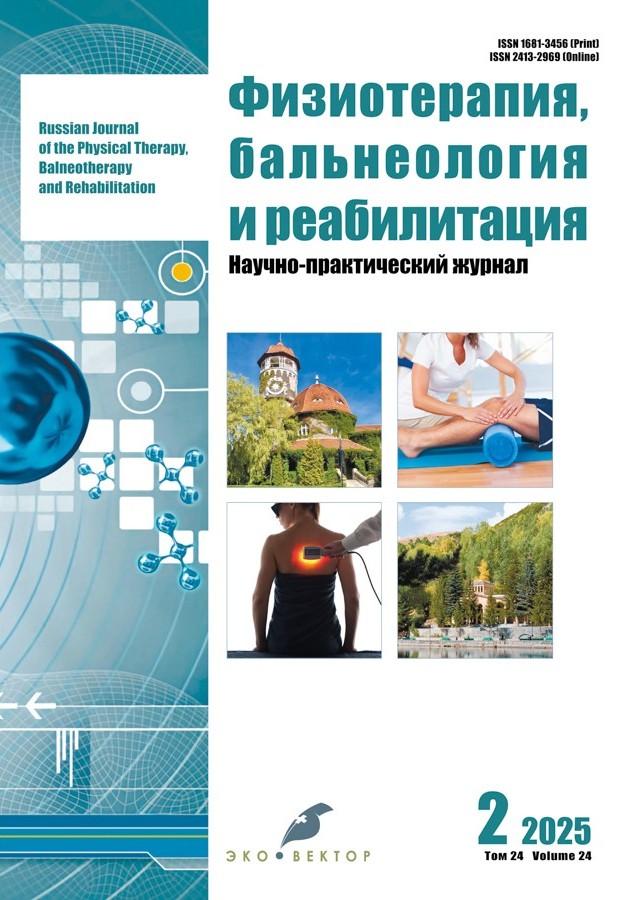体外磁刺激在儿童肛门直肠畸形手术后医疗康复中的应用
- 作者: Lyan N.A.1,2, Khan M.A.1,3, Lvova A.V.1, Menovshchikova L.B.3, Kostomarova E.A.3
-
隶属关系:
- S.I. Spasokukotsky Moscow Centre for Research and Practice in Medical Rehabilitation, Restorative and Sports Medicine
- The First Sechenov Moscow State Medical University
- Filatov Childrens City Clinical Hospital
- 期: 卷 24, 编号 2 (2025)
- 页面: 133-142
- 栏目: Original studies
- ##submission.datePublished##: 19.05.2025
- URL: https://rjpbr.com/1681-3456/article/view/677081
- DOI: https://doi.org/10.17816/rjpbr677081
- EDN: https://elibrary.ru/GJQUDW
- ID: 677081
如何引用文章
详细
现实意义。肛门直肠畸形在儿童先天性发育畸形中占有重要地位。直肠成形术后儿童医疗康复技术的研发是一个亟待解决的问题。医疗康复是针对排便的正常化、增强直肠括约肌、骨盆底肌肉的张力、恢复排便反射和降低自主神经功能障碍。
研究目的 — 论证体外磁刺激在儿童肛门直肠畸形手术后的应用合理性。
材料和方法。在一项开放式对照临床研究中,接受调查的是77名肛门直肠畸形手术的儿童,动态年龄为5.99±3.22岁,分为两组:39名儿童接受了体外磁刺激,38名儿童没有接受物理治疗。所有儿童都接受了运动疗法,包括加强骨盆底肌肉的锻炼。为了评估治疗效果,对会阴和盆底结构进行了超声检查,并对直肠血管进行了多普勒超声检查。
结果。在体外磁刺激下,主要临床症状出现了积极的动态变化,表现为大肠排便功能得到改善,以及大便失禁发作次数的减少。根据超声波检查数据,肛门通道、肌肉外展肌大小(p=0.04)、右侧(p=0.004)和左侧(p=0.012)外括约肌厚度、耻骨直肠环大小(p=0.009)均有明显增加,且有统计学意义。根据直肠下段血管多普勒检查数据,腹腔内血流指标有改善的趋势。在3、6、12个月后,远期结果证实所取得的积极效果下降。
结论。根据已进行的研究确定,体外磁刺激对儿童肛门直肠畸形的主要临床功能指标具有积极作用。远程结果的分析证实,进行体外磁刺激重复疗程的合理性。
全文:
作者简介
Natalia A. Lyan
S.I. Spasokukotsky Moscow Centre for Research and Practice in Medical Rehabilitation, Restorative and Sports Medicine; The First Sechenov Moscow State Medical University
编辑信件的主要联系方式.
Email: nlyan@yandex.ru
ORCID iD: 0000-0003-1566-2739
SPIN 代码: 5391-7523
MD, Cand. Sci. (Medicine), Assistant Professor
俄罗斯联邦, Moscow; MoscowMaya A. Khan
S.I. Spasokukotsky Moscow Centre for Research and Practice in Medical Rehabilitation, Restorative and Sports Medicine; Filatov Childrens City Clinical Hospital
Email: 6057016@mail.ru
ORCID iD: 0000-0002-1081-1726
SPIN 代码: 1070-2800
Dr. Sci. (Medicine), Professor
俄罗斯联邦, Moscow; MoscowAnastasia V. Lvova
S.I. Spasokukotsky Moscow Centre for Research and Practice in Medical Rehabilitation, Restorative and Sports Medicine
Email: nas.lwowa199614@yandex.ru
ORCID iD: 0009-0002-0954-9115
SPIN 代码: 8589-0349
俄罗斯联邦, Moscow
Lyudmila B. Menovshchikova
Filatov Childrens City Clinical Hospital
Email: ludmilam-2205@yandex.ru
ORCID iD: 0000-0002-0780-9254
Dr. Sci. (Medicine), Professor
俄罗斯联邦, MoscowElena A. Kostomarova
Filatov Childrens City Clinical Hospital
Email: elena@alex-art.ru
MD, Cand. Sci. (Medicine)
俄罗斯联邦, Moscow参考
- Narbaev TT, Aliev MM, Yuldashev AYu, Turayeva ZhT. Morphological criteria for surgical treatment of anorectal malformations in children. Pirogov Russian Journal of Surgery. 2021;2:48–52. doi: 10.17116/hirurgia202102148 EDN: CFYHSR
- Degtyarev YuG, Nikiforov AN, Novitskaya SK, Bobrovich TA. Congenital malformations of the anorectal area. Minsk: Four Quarters Publishing House; 2017. (In Russ.)
- Narbayev TT, Tilavov UKh, Turaeva NN, Terebaev BA. Modified stone benson's perineal proctoplastics in low forms of anorectal malformation in children. American Journal of Medicine and Medical Sciences. 2018;8(4):66–70. doi: 10.5923/j.ajmms.20180804.03
- Pimenova ES, Korolev GA. Pathology of the central nervous system in children with anorectal malformations. Pediatric surgery. 2022;26(1):24–28. doi: 10.55308/1560-9510-2022-26-1-24-28 EDN: UWVCRU
- Rintala RJ, Lindahl HG. Fecal continence in patients having undergone posterior sagittal anorectoplasty procedure for a high anorectal malformation improves at adolescence, as constipation disappears. J Pediatr Surg. 2001;36:1218–1221.
- Pena A, Hong A. Advances in the management of anorectal malformations. Am J Surg. 2000;180(5):3706.
- Yeap ZH, Simillis C, Qiu S, et al. Diagnostic accuracy of anorectal manometry for fecal incontinence: a meta-analysis. Acta Chir Belg. 2017;117(6):347–355. doi: 10.1080/00015458.2017.1394674
- Gavrusev AA, Lositsky KG. Extracorporeal pulse magnetic therapy: results and prospects of application in urological practice. Medical news. 2017;(1):50–52. EDN: XSNXWZ
- Struppler A, Angerer B, Gundisch C, et al. Modulatory effect of repetitive peripheral magnetic stimulation on skeletal muscle tone in healthy subjects: stabilization of the elbow joint. Exp Brain Res. 2004;157(1):59–66. doi: 10.1007/s00221-003-1817-6 EDN: FOWURB
- Badalov NG, Borodulina IV, Efimova VI, Yakovlev MYu. Noninvasive peripheral magnetic stimulation in the treatment of neurogenic urination disorders in children. Problems of Balneology, Physiotherapy, and Exercise Therapy. 2023;100(4):18–27. doi: 10.17116/kurort202310004118 EDN: BBQBLA
- Kang SH, Bae JH, Shim KS. Extracorporeal magnetic innervation therapy in children with refractory monosymptomatic nocturnal enuresis. Urology. 2007;70(3):576–80.
- Korchazhkina NB, Khan MA, Chervinskaya AV, et al. Combined methods of halotherapy in medical rehabilitation of children with respiratory diseases. Bulletin of Restorative Medicine. 2018;85(3):58–62. EDN: XTAUFF
- Khan MA, Kotenko KV, Korchazhkina NB, et al. Promising directions of development of halotherapy in pediatrics. Problems of Balneology, Physiotherapy, and Exercise Therapy. 2016;93(6):61–66. doi: 10.17116/kurort2016661-66 EDN: XHUGPX
- Pogonchenkova IV, Khan MA, Korchazhkina NB, et al. Physical factors in medical rehabilitation of children with neurogenic dysfunction of the bladder. Problems of Balneology, Physiotherapy, and Exercise Therapy. 2017;94(6):53–58. doi: 10.17116/kurort201794653-58 EDN: YMOYAK
- Markosyan TG, Korchazhkina NB, Nikitin SS, Bodrov AV. Perineal muscle training in the rehabilitation treatment of patients with chronic prostatitis with latent neurogenic urination disorders. Sports medicine: science and practice. 2013;(2):36–40. EDN: RTOAHH
补充文件







